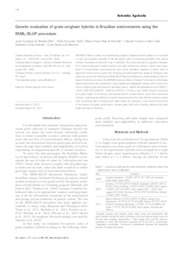Genetic evaluation of grain sorghum hybrids in Brazilian environments using the REML/BLUP procedure.
Genetic evaluation of grain sorghum hybrids in Brazilian environments using the REML/BLUP procedure.
Author(s): ALMEIDA FILHO, J. E. de; TARDIN, F. D.; RESENDE, M. D. V. de; SILVA, F. F. e; GRANATO, I. S. C.; MENEZES, C. B. de
Summary: When it comes to recommending sorghum (Sorghum bicolor) cultivars, it is essential to carry out a genetic evaluation of the agronomic traits of promising genotypes from several common environments where the crop is cultivated. This study consisted of a genetic evaluation of 52 experimental grain sorghum hybrids and eight commercial cultivars. Hybrids were evaluated in 19 experiments representing the most varied cultivation conditions in Brazil. Traits of agronomic interest such as grain yield, fl owering and plant height were analysed. Genotypic evaluation was performed following the REML/BLUP (Restricted Maximum Likelihood/Best Linear Unbiased Predictor) procedure; the MHPRVG (Harmonic Mean of Relative Performance of Genotypic Values) method was also employed to study stability and adaptability. Hybrids which stood out in terms of highest grain yield based on genotypic values, stability and adaptability were 0306037, 1G150, DKB 599, 0306039, 1G282 and 0307671. Of these, only 1G282 showed restrictions as to plant height. For fl owering, experimental hybrids showed shorter cycles than commercial cultivars, confi rming the effi ciency of genetic improvement for this trait. With the analysis of grain yield considering days to fl owering and plant height as covariates, it was observed that most of the hybrids of greater performance, showed grain yield to be positively infl uenced by plant height and days to fl owering.
Publication year: 2014
Types of publication: Journal article
Unit: Embrapa Maize & Sorghum
Keywords: Avaliação genética, Genotype, Genótipo, Hybrids, Híbrido, Melhoramento genético, Sorghum bicolor, Sorgo
Observation
Some of Embrapa's publications are published as ePub files. To read them, use or download one of the following free software options to your computer or mobile device. Android: Google Play Books; IOS: iBooks; Windows and Linux: Calibre.
Access other publications
Access the Agricultural Research Database (BDPA) to consult Embrapa's full library collection and records.
Visit Embrapa Bookstore to purchase books and other publications sold by Embrapa.

